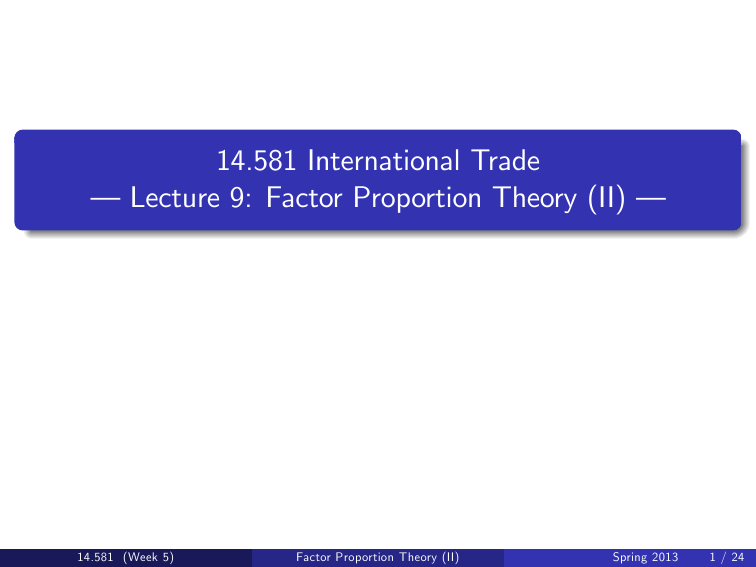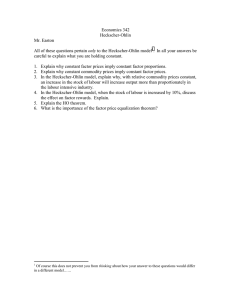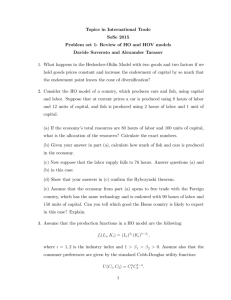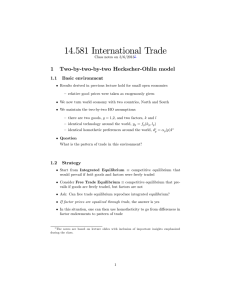14.581 International Trade — Lecture 9: Factor Proportion Theory (II) — 14.581
advertisement

14.581 International Trade — Lecture 9: Factor Proportion Theory (II) — 14.581 Week 5 Spring 2013 14.581 (Week 5) Factor Proportion Theory (II) Spring 2013 1 / 24 Today’s Plan 1 Two-by-two-by-two Heckscher-Ohlin model 1 2 2 High-dimensional issues 1 2 3 Integrated equilibrium Heckscher-Ohlin Theorem Classical theorems revisited Heckscher-Ohlin-Vanek Theorem Quantitative Issues 14.581 (Week 5) Factor Proportion Theory (II) Spring 2013 2 / 24 Two-by-two-by-two Heckscher-Ohlin model Basic environment Results derived in previous lecture hold for small open economies relative good prices were taken as exogenously given We now turn world economy with two countries, North and South We maintain the two-by-two HO assumptions: there are two goods, g = 1,2, and two factors, k and l identical technology around the world, yg = fg (kg , lg ) identical homothetic preferences around the world, dgc = αg (p )I c Question What is the pattern of trade in this environment? 14.581 (Week 5) Factor Proportion Theory (II) Spring 2013 3 / 24 Two-by-two-by-two Heckscher-Ohlin model Strategy Start from Integrated Equilibrium competitive equilibrium that would prevail if both goods and factors were freely traded Consider Free Trade Equilibrium competitive equilibrium that prevails if goods are freely traded, but factors are not Ask: Can free trade equilibrium reproduce integrated equilibrium? If factor prices are equalized through trade, the answer is yes In this situation, one can then use homotheticity to go from di¤erences in factor endowments to pattern of trade 14.581 (Week 5) Factor Proportion Theory (II) Spring 2013 4 / 24 Two-by-two-by-two Heckscher-Ohlin model Integrated equilibrium Integrated equilibrium corresponds to (p, ω, y ) such that: (ZP ) : (GM ) : (FM ) : p = A0 ( ω ) ω (1) 0 y = α (p ) ω v (2) v = A (ω ) y (3) where: p (p1 , p2 ), ω (w , r ), A (ω ) afg (ω ) , y α (p ) [α1 (p ) , α2 (p )] A (ω ) derives from cost-minimization α (p ) derives from utility-maximization 14.581 (Week 5) Factor Proportion Theory (II) ( y1 , y2 ) , v Spring 2013 (l, k ), 5 / 24 Two-by-two-by-two Heckscher-Ohlin model Free trade equilibrium Free trade equilibrium corresponds to (p t , ω n , ω s , y n , y s ) such that: (ZP ) : (GM ) : (FM ) : pt n A0 (ω c ) ω c for c = n, s s y +y = α p c c t n0 n (4) s0 s ω v +ω v c v = A (ω ) y for c = n, s (5) (6) where (4) holds with equality if good is produced in country c De…nition Free trade equilibrium replicates integrated equilibrium if 9 (y n , y s ) 0 such that (p, ω, ω, y n , y s ) satisfy conditions (4)-(6) 14.581 (Week 5) Factor Proportion Theory (II) Spring 2013 6 / 24 Two-by-two-by-two Heckscher-Ohlin model Factor Price Equalization (FPE) Set De…nition (v n , v s ) are in the FPE set if 9 (y n , y s ) condition (6) holds for ω n = ω s = ω. 0 such that Lemma If (v n , v s ) is in the FPE set, then free trade equilibrium replicates integrated equilibrium Proof: By de…nition of the FPE set, 9 (y n , y s ) 0 such that v c = A (ω ) y c So Condition (6) holds. Since v = v n + v s , this implies v = A ( ω ) (y n + y s ) Combining this expression with condition (3), we obtain y n + y s = y . Since ω n 0 v n + ω s 0 v s = ω 0 v , Condition (5) holds as well. Finally, Condition (1) directly implies (4) holds. 14.581 (Week 5) Factor Proportion Theory (II) Spring 2013 7 / 24 Two-by-two-by-two Heckscher-Ohlin model Integrated equilibrium: graphical analysis Factor market clearing in the integrated equilibrium: v y2a2(ω) k a2(ω) y1a1(ω) a1(ω) O l 14.581 (Week 5) Factor Proportion Theory (II) Spring 2013 8 / 24 Two-by-two-by-two Heckscher-Ohlin model The “Parallelogram” FPE set (v n , v s ) inside the parallelogram ls Os v y2a2(ω) ks vs kn a2(ω) vn y1a1(ω) a1(ω) On ln When v n and v s are inside the parallelogram, we say that they belong to the same diversi…cation cone This is a very di¤erent way of approaching FPE than FPE Theorem Here, we have shown that there can be FPE i¤ factor endowments are not too dissimilar, whether or not there are no FIR Instead of taking prices as given— whether or not they are consistent with integrated equilibrium— we take factor endowments as primitives 14.581 (Week 5) Factor Proportion Theory (II) Spring 2013 9 / 24 Two-by-two-by-two Heckscher-Ohlin model Heckscher-Ohlin Theorem: graphical analysis Suppose that (v n , v s ) is in the FPE set HO Theorem In the free trade equilibrium, each country will export the good that uses its abundant factor intensively ls Os v ks vs kn vn C Slope = w/r On ln Outside the FPE set, additional technological and demand considerations matter (e.g. FIR or no FIR) 14.581 (Week 5) Factor Proportion Theory (II) Spring 2013 10 / 24 Two-by-two-by-two Heckscher-Ohlin model Heckscher-Ohlin Theorem: alternative proof HO Theorem can also be derived using Rybczynski e¤ect: 1 2 3 4 Rybczynski theorem ) y2n /y1n > y2s /y1s for any p Homotheticity ) c2n /c1n = c2s /c1s for any p This implies p2n /p1n < p2s /p1s under autarky Law of comparative advantage ) HO Theorem 14.581 (Week 5) Factor Proportion Theory (II) Spring 2013 11 / 24 Two-by-two-by-two Heckscher-Ohlin model Trade and inequality Predictions of HO and SS Theorems are often combined: HO Theorem ) p2n /p1n < p2 /p1 < p2s /p1s SS Theorem ) Moving from autarky to free trade, real return of abundant factor increases, whereas real return of scarce factor decreases If North is skill-abundant relative to South, inequality increases in the North and decreases in the South So why may we observe a rise in inequality in the South in practice? Southern countries are not moving from autarky to free trade Technology is not identical around the world Preferences are not homothetic and identical around the world There are more than two goods and two countries in the world 14.581 (Week 5) Factor Proportion Theory (II) Spring 2013 12 / 24 Two-by-two-by-two Heckscher-Ohlin model Trade volumes Let us de…ne trade volumes as the sum of exports plus imports Inside FPE set, iso-volume lines are parallel to diagonal (HKa p.23) the further away from the diagonal, the larger the trade volumes factor abundance rather than country size determines trade volume volumes ls Os ks y2a2(ω) kn a2(ω) y1a1(ω) a1(ω) On 4 .pdf ln If country size a¤ects trade volumes in practice, what should we infer? 14.581 (Week 5) Factor Proportion Theory (II) Spring 2013 13 / 24 High-Dimensional Predictions FPE (I): More factors than goods Suppose now that there are F factors and G goods By de…nition, (v n , v s ) is in the FPE set if 9 (y n , y s ) 0 s.t. v c = A (ω ) y c for c = n, s If F = G (“even case”), the situation is qualitatively similar If F > G , the FPE set will be “measure zero”: fv jv = A (ω ) y c for y c 0g is a G -dimensional cone in F -dimensional space Example: “Macro” model with 1 good and 2 factors ls vs kn Os ks vn a(ω) n O 14.581 (Week 5) ln Factor Proportion Theory (II) Spring 2013 14 / 24 High-Dimensional Predictions FPE (II): More goods than factors If F < G , there will be indeterminacies in production, (y n , y s ), and so, trade patterns, but FPE set will still have positive measure Example: 3 goods and 2 factors ls Os y1a1(ω) y2a2(ω) v ks s v y3a3(ω) kn a3(ω) vn a (ω) 2 a1(ω) n O ln By the way, are there more goods than factors in the world? 14.581 (Week 5) Factor Proportion Theory (II) Spring 2013 15 / 24 High-Dimensional Predictions Stolper-Samuelson-type results (I): “Friends and Enemies” SS Theorem was derived by di¤erentiating zero-pro…t condition With an arbitrary number of goods and factors, we still have p bg = ∑f θ fg w bf where wf is the price of factor f and θ fg (7) wf afg (ω ) /cg (ω ) Now suppose that p bg0 > 0, whereas p bg = 0 for all g 6= g0 Equation (7) immediately implies the existence of f1 and f2 s.t. w bf 1 w bf 2 p bg0 > p bg = 0 for all g 6= g0 , < pbg = 0 < pbg0 for all g 6= g0 . So every good is “friend” to some factor and “enemy” to some other (Jones and Scheinkman 1977) 14.581 (Week 5) Factor Proportion Theory (II) Spring 2013 16 / 24 High-Dimensional Predictions Stolper-Samuelson-type results (II): Correlations Ethier (1984) also provides the following variation of SS Theorem If good prices change from p to p 0 , then the associated change in factor prices, ω 0 ω, must satisfy ω0 ω A (ω 0 ) p 0 p > 0, for some ω 0 between ω and ω 0 Proof: De…ne f (ω ) = ωA (ω ) (p 0 f ω 0 = ωA (ω ) p 0 p ). Mean value theorem implies p + ω0 ω [A (ω 0 ) + ω 0 dA (ω 0 )] p 0 p for some ω 0 between ω and ω 0 . Cost-minimization at ω 0 requires ω 0 dA (ω 0 ) = 0 14.581 (Week 5) Factor Proportion Theory (II) Spring 2013 17 / 24 High-Dimensional Predictions Stolper-Samuelson-type results (II): Correlations Proof (Cont.): Combining the two previous expressions, we obtain f ω0 f (ω ) = ω 0 ω A (ω 0 ) p 0 p From zero pro…t condition, we know that p = ωA (ω ) and p 0 = ω 0 A (ω 0 ). Thus f ω0 f (ω ) = p 0 p p0 p >0 The last two expressions imply ω0 ω A (ω 0 ) p 0 p >0 Interpretation: Tendency for changes in good prices to be accompanied by raises in prices of factors used intensively in goods whose prices have gone up What is ω 0 ? 14.581 (Week 5) Factor Proportion Theory (II) Spring 2013 18 / 24 High-Dimensional Predictions Rybczynski-type results Rybczynski Theorem was derived by di¤erentiating the factor market clearing condition If G = F > 2, same logic implies that increase in endowment of one factor decreases output of one good and increases output of another (Jones and Scheinkman 1977) If G < F , increase in endowment of one factor may increase output of all goods (Ricardo-Viner) In this case, we still have the following correlation (Ethier 1984) v0 v A (ω ) y 0 y = v0 v v0 v >0 If G > F , inderteminacies in production imply that we cannot predict changes in output vectors 14.581 (Week 5) Factor Proportion Theory (II) Spring 2013 19 / 24 High-Dimensional Predictions Heckscher-Ohlin-type results Since HO Theorem derives from Rybczynski e¤ect + homotheticity, problems of generalization in the case G < F and F > G carry over to the Heckscher-Ohlin Theorem If G = F > 2, we can invert the factor market clearing condition yc = A 1 (ω ) v c By homotheticity, the vector of consumption in country c satis…es dc = sc d where s c c’s share of world income, and d Good and factor market clearing requires 1 d =y =A world consumption (ω ) v Combining the previous expressions, we get net exports tc 14.581 (Week 5) yc dc = A 1 ( ω ) (v c Factor Proportion Theory (II) sc v ) Spring 2013 20 / 24 High-Dimensional Predictions Heckscher-Ohlin-Vanek Theorem Without assuming that G = F , we can still derive sharp predictions if we focus on the factor content of trade rather than commodity trade We de…ne the net exports of factor f by country c as τ cf = ∑g afg (ω ) tgc In matrix terms, this can be rearranged as τ c = A (ω ) t c HOV Theorem In any country c, net exports of factors satisfy τc = v c sc v So countries should export the factors in which they are abundant compared to the world: vfc > s c vf Assumptions of HOV Theorem are extremely strong: identical technology, FPE, homotheticity One shouldn’t be too surprised if it performs miserably in practice... 14.581 (Week 5) Factor Proportion Theory (II) Spring 2013 21 / 24 Quantitative Issues Basic Idea Stolper-Samuelson o¤ers sharp insights about distributional consequences of international trade, but... Theoretical insights are only qualitative Theoretical insights crucially rely on 2 2 assumptions Alternatively one may want to know the quantitative importance of international trade: Given the amount of trade that we actually observe in the data, how large are the e¤ects of international trade on the skill premium? In a country like the United States, how much higher or smaller would the skill premium be in the absence of trade? 14.581 (Week 5) Factor Proportion Theory (II) Spring 2013 22 / 24 Quantitative Issues Eaton and Kortum (2002) Revisited Eaton and Kortum (2002)— as well as other gravity models— o¤er a simple starting point to think about these issues Consider multi-sector-multi-factor EK (e.g. Chor JIE 2010) many varieties with di¤erent productivity levels z (ω ) in each sector s same factor intensity across varieties within sectors di¤erent factor intensities across sectors Unit costs of production in country i and sector s are proportional to: ci ,s = µH s ρ wiH 1 ρ + µLs ρ wiL 1 ρ 1/(1 ρ) (8) where: wiH , wiL wages of skilled and unskilled workers. ρ elasticity of substitution between skilled and unskilled 14.581 (Week 5) Factor Proportion Theory (II) Spring 2013 23 / 24 Quantitative Issues Dekle, Eaton, and Kortum (2008) Revisited Suppose, like in EK, that productivity draws across varieties within sectors are independently drawn from a Fréchet Then one can show that the following gravity equation holds: Xij ,s = where Ej ,s Ti (τ ij ,s ci ,s ) θs ∑nl=1 Tl (τ lj ,s cl ,s ) θs Ej ,s , (9) total expenditure on goods from sector s in country j Two key equations, (8) and (9), are CES: One can use DEK’s strategy to do welfare and counterfactual analysis But one can also discuss the consequences of changes in variable trade costs, τ lj ,s , or technology, Ti , on skill premium How large are GT compared to distributional consequences? 14.581 (Week 5) Factor Proportion Theory (II) Spring 2013 24 / 24 MIT OpenCourseWare http://ocw.mit.edu 14.581 International Economics I Spring 2013 For information about citing these materials or our Terms of Use, visit: http://ocw.mit.edu/terms.





